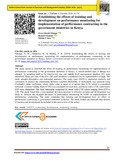EFFECT OF PROJECT MONITORING PRACTICES ON COMPLETION OF AIRSTRIP PROJECTS IN KENYA: A CASE OF LANET AIRSTRIP, NAKURU COUNTY
Abstract
This study aimed to determine the effect of project monitoring practices on the completion
of airstrip projects in Kenya, focusing on the case of Lanet Airstrip in Nakuru County. The
specific objectives of the study were to determine the impact of financial monitoring,
examine the effect of technical monitoring, evaluate the influence of risk monitoring, and
establish the effect of project process monitoring on the completion of airstrip projects.
The study was guided by the Theory of Change and Theory of Constraints. A descriptive
research design was employed to gather information. The study took place at Lanet
Airstrip, which is located at the 80 Tank Battalion Barracks in Nakuru County. The target
population for the study includes 95 personnel involved in the Lanet Airstrip construction
project, comprising engineers, construction officers, project managers, site agents, and
surveyors. A census approach was used to include the entire target population of 95
respondents, considering the small and easily accessible nature of the population. Primary
data was collected using questionnaires with closed-ended questions to obtain measurable
and quantitative data and eliminate irrelevant answers. The Social Sciences Statistical
Package (SPSS) version 25 was used for data analysis, employing a regression model to
examine the relationship between the variables. Presentations were in tables. This research
discovered strong links between various monitoring procedures and the prevalence of
delayed airstrip projects in Kenya. Financial Monitoring, Technical Monitoring, Risk
Monitoring, and Project Process Monitoring all showed significant relationships with
project delays, highlighting their crucial roles in project outcomes. Effective financial
control, stringent technical oversight, thorough risk management, and meticulous project
process monitoring are identified as critical techniques for reducing the chance of project
failure to be completed on time. The adoption of clear financial procedures, training
programs, access to technical specialists, risk management techniques, adherence to
worldwide project management standards, and a culture of continual improvement were
all recommended. Furthermore, it was noted that future research should consider
previously unexplored external factors such as economic conditions, political stability,
stakeholder engagement, and environmental aspects to provide a more holistic
understanding of the complex dynamics influencing project success in Kenya's airstrip
development context.
Collections
Related items
Showing items related by title, author, creator and subject.
-
INTERNET OF THINGS BASED MODEL FOR PREECLAMPSIA MONITORING IN ANTENATAL CARE
MUSYOKA, FAITH MUENI (KABARAK UNIVERSITY, 2019-11)In the health sector, the health of women is a significant public health issue, which impacts the personal well-being, family reproduction, and societal development. Therefore, knowledge about the health of women has led ... -
Establishing the effects of training and development on performance monitoring for implementation of performance contracting in the government ministries in Kenya
Ndungu, Grace Mumbi; Chepkilot, Ronald; Keta, Midida P. (Editon Consortium Journal of Business and Management Studies, 2024-11)The study aimed to establish the effect of training on performance monitoring for implementation of performance contracting in the government ministries in Kenya. A mixed-method type of design was adopted. In sampling ... -
Influence of Monitoring and Evaluation Strategy on Implementation Of Donor Assisted EHealth Management Systems In Public Health Facilities In Nakuru County
CHEMUTAI, Purity; WAIGANJO, Maina; RAGAMA, Phillip; TANUI, John K. (KABARAK UNIVERSITY, 2018-10-14)Thepurpose of this study was to analyze the influence of monitoring and evaluationstrategy on implementation of donor assisted e-health management systems in public health facilities in Nakuru County, Kenya. Descriptive ...




